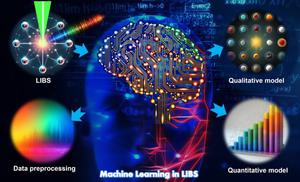Frontiers of Physics ( IF 6.5 ) Pub Date : 2024-07-12 , DOI: 10.1007/s11467-024-1427-2 Zhongqi Hao , Ke Liu , Qianlin Lian , Weiran Song , Zongyu Hou , Rui Zhang , Qianqian Wang , Chen Sun , Xiangyou Li , Zhe Wang

|
Laser-induced breakdown spectroscopy (LIBS) is a spectroscopic analytic technique with great application potential because of its unique advantages for online/in-situ detection. However, due to the spatially inhomogeneity and drastically temporal varying nature of its emission source, the laser-induced plasma, it is difficult to find or hard to generate an appropriate spatiotemporal window for high repeatable signal collection with lower matrix effects. The quantification results of traditional physical principle based calibration model are unsatisfactory since these models were not able to compensate for complicate matrix effects as well as signal fluctuation. Machine learning is an emerging approach, which can intelligently correlated the complex LIBS spectral data with its qualitative or/and quantitative composition by establishing multivariate regression models with greater potential to reduce the impacts of signal fluctuation and matrix effects, therefore achieving relatively better qualitative and quantitative performance. In this review, the progress of machine learning application in LIBS is summarized from two main aspects: i) Pre-processing data for machine learning model, including spectral selection, variable reconstruction, and denoising to improve qualitative/quantitative performance; ii) Machine learning methods for better quantification performance with reduction of the impact of matrix effect as well as LIBS spectra fluctuations. The review also points out the issues that researchers need to address in their future research on improving the performance of LIBS analysis using machine learning algorithms, such as restrictions on training data, the disconnect between physical principles and algorithms, the low generalization ability and massive data processing ability of the model.
中文翻译:

激光诱导击穿光谱中的机器学习:综述
激光诱导击穿光谱(LIBS)是一种具有巨大应用潜力的光谱分析技术,因其在线/原位检测的独特优势。然而,由于其发射源激光诱导等离子体的空间不均匀性和剧烈的时间变化性质,很难找到或难以生成适当的时空窗口来以较低的基质效应进行高可重复信号收集。传统基于物理原理的校准模型的量化结果并不令人满意,因为这些模型无法补偿复杂的矩阵效应以及信号波动。机器学习是一种新兴的方法,通过建立具有更大潜力的多元回归模型,将复杂的LIBS光谱数据与其定性或/和定量成分智能关联起来,以减少信号波动和矩阵效应的影响,从而获得相对更好的定性和定量结果表现。本文从两个主要方面总结了机器学习在LIBS中的应用进展:i)机器学习模型的数据预处理,包括光谱选择、变量重建和去噪,以提高定性/定量性能; ii) 机器学习方法可实现更好的量化性能,减少基质效应和 LIBS 光谱波动的影响。 综述还指出了研究人员在未来利用机器学习算法提高LIBS分析性能的研究中需要解决的问题,如训练数据的限制、物理原理与算法的脱节、泛化能力低和海量数据等。模型的处理能力。











































 京公网安备 11010802027423号
京公网安备 11010802027423号